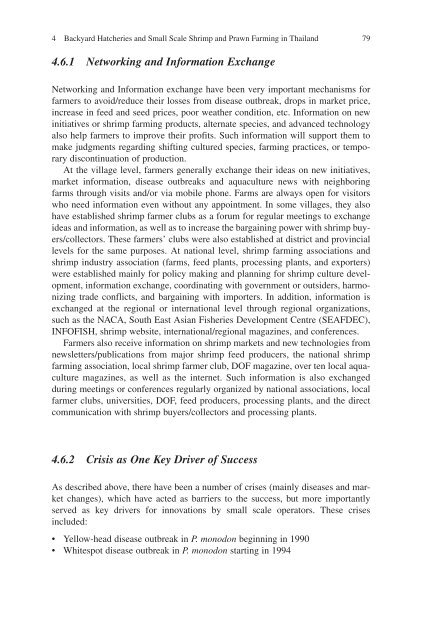Success Stories In Asian Aquaculture - Library - Network of ...
Success Stories In Asian Aquaculture - Library - Network of ...
Success Stories In Asian Aquaculture - Library - Network of ...
- No tags were found...
You also want an ePaper? Increase the reach of your titles
YUMPU automatically turns print PDFs into web optimized ePapers that Google loves.
4 Backyard Hatcheries and Small Scale Shrimp and Prawn Farming in Thailand794.6.1 <strong>Network</strong>ing and <strong>In</strong>formation Exchange<strong>Network</strong>ing and <strong>In</strong>formation exchange have been very important mechanisms forfarmers to avoid/reduce their losses from disease outbreak, drops in market price,increase in feed and seed prices, poor weather condition, etc. <strong>In</strong>formation on newinitiatives or shrimp farming products, alternate species, and advanced technologyalso help farmers to improve their pr<strong>of</strong>its. Such information will support them tomake judgments regarding shifting cultured species, farming practices, or temporarydiscontinuation <strong>of</strong> production.At the village level, farmers generally exchange their ideas on new initiatives,market information, disease outbreaks and aquaculture news with neighboringfarms through visits and/or via mobile phone. Farms are always open for visitorswho need information even without any appointment. <strong>In</strong> some villages, they alsohave established shrimp farmer clubs as a forum for regular meetings to exchangeideas and information, as well as to increase the bargaining power with shrimp buyers/collectors.These farmers’ clubs were also established at district and provinciallevels for the same purposes. At national level, shrimp farming associations andshrimp industry association (farms, feed plants, processing plants, and exporters)were established mainly for policy making and planning for shrimp culture development,information exchange, coordinating with government or outsiders, harmonizingtrade conflicts, and bargaining with importers. <strong>In</strong> addition, information isexchanged at the regional or international level through regional organizations,such as the NACA, South East <strong>Asian</strong> Fisheries Development Centre (SEAFDEC),INFOFISH, shrimp website, international/regional magazines, and conferences.Farmers also receive information on shrimp markets and new technologies fromnewsletters/publications from major shrimp feed producers, the national shrimpfarming association, local shrimp farmer club, DOF magazine, over ten local aquaculturemagazines, as well as the internet. Such information is also exchangedduring meetings or conferences regularly organized by national associations, localfarmer clubs, universities, DOF, feed producers, processing plants, and the directcommunication with shrimp buyers/collectors and processing plants.4.6.2 Crisis as One Key Driver <strong>of</strong> <strong>Success</strong>As described above, there have been a number <strong>of</strong> crises (mainly diseases and marketchanges), which have acted as barriers to the success, but more importantlyserved as key drivers for innovations by small scale operators. These crisesincluded:• Yellow-head disease outbreak in P. monodon beginning in 1990• Whitespot disease outbreak in P. monodon starting in 1994
















